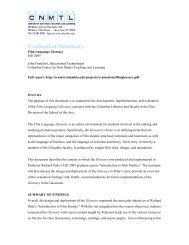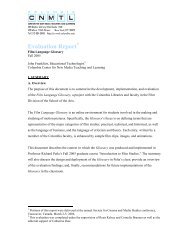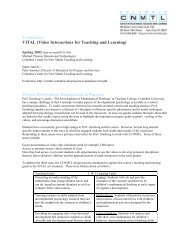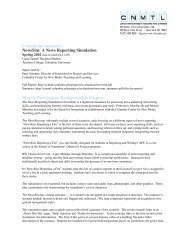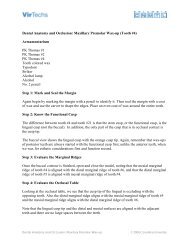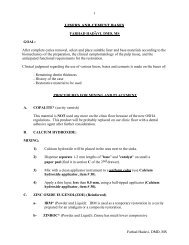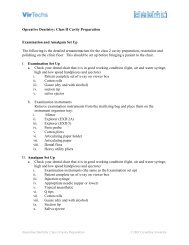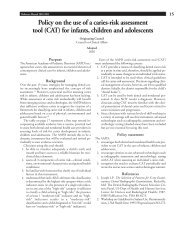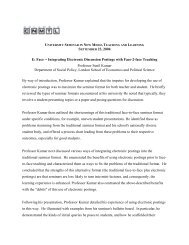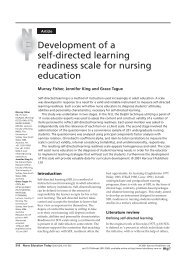Evaluation Summary: Arthur C. Danto's "The Artworld" - Columbia ...
Evaluation Summary: Arthur C. Danto's "The Artworld" - Columbia ...
Evaluation Summary: Arthur C. Danto's "The Artworld" - Columbia ...
You also want an ePaper? Increase the reach of your titles
YUMPU automatically turns print PDFs into web optimized ePapers that Google loves.
<strong>Evaluation</strong> <strong>Summary</strong>:<br />
<strong>Arthur</strong> C. Danto’s “<strong>The</strong> Artworld”<br />
Fall 2001 (last revised 04-15-03)<br />
Arlene Atherton, <strong>Evaluation</strong> Assistant<br />
<strong>Columbia</strong> Center for New Media Teaching and Learning<br />
Supervized by:<br />
Peter Sommer, Director of Education for Projects and Services<br />
<strong>Columbia</strong> Center for New Media Teaching and Learning<br />
Full Report: http://ccnmtl.columbia.edu/projects/evaluations/danto.pdf<br />
<strong>Summary</strong>: http://ccnmtl.columbia.edu/projects/evaluations/danto_summary.pdf (this document)<br />
Project Description: Background & Purpose<br />
History of the Multimedia Study Environment:<br />
Predecessor to CCNMTL’s multimedia study environment was its multimedia template (MMT). <strong>The</strong> multimedia<br />
template began as a tool to facilitate close readings of primary source material. It featured hyperlinks to reference<br />
sources, such as encyclopedias, dictionaries, and biographies, as well as referenced art work. <strong>The</strong> purpose was to<br />
create a digital desktop of the textual material an instructor would guide a student to consult when studying an essay.<br />
A major innovation of the MMT was the use of a split window, with the right frame containing the primary text and<br />
the left frame containing reference sources and other supporting material. <strong>The</strong> resources area created a context for<br />
the core text by linking it to biographical profiles, glossaries of concepts and terms, images, authors’ notes (not<br />
editorial commentary), and links to relevant web sites.<br />
<strong>The</strong> second generation of the MMT utilized the same split window template, but added instructors’ comments to the<br />
resources menu to further enhance understanding of the primary text or spine document. <strong>The</strong> third generation used<br />
the same format and integrated the original idea of a reference index with visual icons and expanded the breadth of<br />
resources to include multiple versions and alternative interpretations of the primary text; the King Lear MMT, for<br />
example, contains six variations of film direction and characterization.<br />
<strong>The</strong> idea that the MMT could provide context through links to outside reference resources soon grew beyond the<br />
text-based to include the other types of media, such as film and music clips, and still images. <strong>The</strong> desktop as a<br />
unified view of continuously displayed content with pop-up windows and related material in various formats adds<br />
another dimension to the idea of studying written text through other written texts. Indeed, it creates a research<br />
framework, thus extending the MMT from a study aid to a study environment.<br />
Concept behind the Multimedia Study Environment<br />
<strong>The</strong> present generation of the MMT, the Multimedia Study Environment (MSE), further expands the learning setting<br />
paradigm by increasing the breadth of resources and supplementary study materials available to aid in the analysis of<br />
the primary text. <strong>The</strong> spine document itself is expanded to include sub-discussions around key paragraphs. This<br />
enables the experienced instructor to layer various arguments into the primary text for further analysis. <strong>The</strong>se<br />
arguments are then linked to specific cases and settings, or to related material that describes the pivot points for new<br />
theory. This approach not only provides historical background and elucidates terminology, it also illuminates salient<br />
concepts with supporting evidence [upon which a decision has been made]. In this manner, the MSE increases the<br />
depth of academic study.
Initially, hypermedia’s ability to improve learning performance was unknown; it was believed that “Hypermedia<br />
might work better as an information retrieval interface than as a learning enhancing tool” (Lehto et al. 1995).<br />
However, “Hypermedia presentation is considered to improve comprehension by virtue of its capability of<br />
supporting structured access, rapid manipulation, and individual learner control” (Dillon and Gabbard 1998, 5).<br />
Hyperlink technology allows media presentation to employ a variety of sensory experiences. Other means of<br />
receiving sequenced information, such as film and video, engage mental imagery and audio imprinting. This<br />
sensory input is operationally different from that gained by reading. Sensory input maps onto long-term memory<br />
under different cues that may aid the student not only in cross-referencing material, but also in information retrieval.<br />
Thus, hypermedia has the potential to be a powerful learning enhancing tool.<br />
Project Description<br />
“<strong>Arthur</strong> C. Danto’s ‘<strong>The</strong> Artworld’” is a multimedia study environment for <strong>Arthur</strong> C. Danto’s 1964 essay, “<strong>The</strong><br />
Artworld”. It is designed for the continuous display of content in the main viewing window and the left resources<br />
window. Like its predecessors, the Danto MSE creates a context for the spine document through links to various<br />
kinds and forms of supplementary material. In addition to relevant texts and digital representations of artworks, the<br />
MSE also includes new video interviews with the text’s author <strong>Arthur</strong> C. Danto, a <strong>Columbia</strong> University Professor<br />
Emeritus, taped in 2001.<br />
Hypermedia technology recreates the experience of traditional study, in which a combination of external<br />
resources, including encyclopedias, dictionaries, biographies, period films, and related essays are brought<br />
to bear on the primary text<br />
<strong>The</strong> simultaneous view of the primary text and supplementary resource material does not require the user to divide<br />
his or her attention between reference questions and the essay. "<strong>Arthur</strong> C. <strong>Danto's</strong> ‘<strong>The</strong> Artworld’" affords users the<br />
option of continuously using all available resources to investigate the core document without obscuring the text of<br />
the essay.<br />
Overview of the <strong>Evaluation</strong> Process<br />
Goals<br />
<strong>The</strong> evaluation aims to determine: 1) the effectiveness of the MSE as a learning enhancing tool irrespective of<br />
subject, and 2) the capacity of the MSE to enhance students’ understanding of Danto’s philosophy of aesthetics.<br />
<strong>The</strong> Effectiveness of the Multimedia Study Environment<br />
Effectiveness was considered in view of students’ intuitive approach to the MSE’s hypermedia format and<br />
simultaneous presentation of various resources on a single viewing platform.<br />
Engaging the Multimedia Study Environment<br />
<strong>The</strong> MSE is a new format for multiple content presentation. As such, is there something intuitive about the manner<br />
in which people utilize this format? Are there characteristics that operate as universals and others that are specific to<br />
particular learning styles? Answers to these questions may be useful to both designers and instructors, especially in<br />
regard to introducing the MSE to potential users.<br />
Effectiveness of the Technology<br />
This was evaluated on the basis of the MSE’s navigability, graphic presentation, site design, and information<br />
architecture.<br />
2
How Does "<strong>Arthur</strong> C. <strong>Danto's</strong> ‘<strong>The</strong> Artworld’" Enrich Students’ Understanding of Danto’s Philosophy of<br />
Aesthetics?<br />
<strong>The</strong> second goal looks at how the addition of supplementary resources affects the learning process. It involves<br />
consideration of the appropriateness of the resources to the primary text for learning comprehension, as well as the<br />
arrangement of these resources within the MSE.<br />
Modifications in the Teaching Process<br />
Introducing a new form of media or a new teaching tool to the classroom requires adjustments on the part both<br />
students and instructors. What factors aid in the integration of new technology to the learning environment? What<br />
obstacles do instructors typically face in attempting to incorporate a MSE into their courses? What can the<br />
CCNMTL do to facilitate the integration process?<br />
Methodology<br />
“<strong>Arthur</strong> C. Danto’s ‘<strong>The</strong> Artworld’” is in the formative stage of development. In the fall of 2001 there was no<br />
means to evaluate the use of the MSE in an natural learning setting because no courses were using it that semester.<br />
<strong>The</strong> absence of a course makes it difficult to assess learning outcome, since base-line information about student<br />
achievement is lacking. <strong>The</strong> present evaluation is therefore based on 1) observation of the learning process as a selfselected<br />
sample of students engages the MSE, and 2) the efficiency of the technology and congruity of content<br />
presentation.<br />
Focus Group Recruiting<br />
Student engagement with the MSE was observed through a focus group of 7 participants. <strong>The</strong> sample was drawn<br />
from both the undergraduate and graduate student populations of <strong>Columbia</strong> University.<br />
Focus Group - Study Design<br />
<strong>The</strong> focus group was conducted in four parts: 1) a presentation by the Project Manager 2) a period of independent<br />
exploration of the MSE 3) a sample essay question to answer using the MSE, and 4) a discussion of the quality of<br />
learning that occurred in the environment and of issues pertaining to the MSE’s use, presentation and construction.<br />
Focus Group - Documentation<br />
Participants’ experiences were documented by means of written survey questionnaires administered at the end of<br />
each part of the focus group, direct observation of their engagement with the MSE, and a videotaped group<br />
discussion.<br />
<strong>Evaluation</strong> of Learning Outcome<br />
A smaller sample of students was asked to view the MSE and answer a sample question designed by Professor<br />
Michael Kelly, CCNMTL’s faculty partner in constructing the Danto MSE. Each of these students was then<br />
interviewed on video about their thought processes, awareness, and learning regarding Danto’s philosophy of<br />
aesthetics.<br />
Faculty Survey Regarding “<strong>Arthur</strong> C. <strong>Danto's</strong> ‘<strong>The</strong> Artworld’” and the Learning Environment<br />
A faculty questionnaire was also administered to investigate the integration of “<strong>Arthur</strong> C. Danto’s ‘<strong>The</strong> Artworld’”<br />
into courses currently offered at <strong>Columbia</strong> University.<br />
Findings<br />
Goal One: Engaging the MSE<br />
With respect to the MSE as a subject-independent presentation platform, the study found that those whose cognitive<br />
style predisposes them to attend to context rather than specific issues benefited from the MSE’s multiple resource<br />
3
platform, while those with the latter cognitive style were more or less unaffected by it - that is, it neither facilitated<br />
nor impeded their preferred approach to learning.<br />
Goal Two: <strong>The</strong> Effectiveness of the MSE<br />
<strong>The</strong> second objective of the study was to determine the effectiveness of the MSE in presenting a given subject;<br />
namely, <strong>Arthur</strong> C. Danto’s theory of aesthetics. It assessed whether the use of hyperlink technology advanced<br />
students’ understanding of a primary text, Danto’s “<strong>The</strong> Artworld.”<br />
<strong>The</strong> study participants’ response to the MSE in this regard was overwhelmingly positive. “I had the feeling it was<br />
much more efficient and much more fun than the traditional style.” Studies of hypermedia indicate that format (i.e.,<br />
traditional vs. hyperlinked text) does not impact students’ approach to learning; this is natural to the individual<br />
student. However, the wealth of information and rapid access to it that hypermedia format enables increases the rate<br />
at which they assimilate the subject matter.<br />
Text vs. Resources<br />
Evidence from the study indicates that participants’ attention was focused primarily on the spine document, rather<br />
than on the supplementary resources. <strong>The</strong> following table shows the percentage of users who reported spending<br />
relatively more time with a particular component of the MSE.<br />
Text 66%<br />
Interviews/Film 44%<br />
Bios 22%<br />
Notes 22%<br />
Slideshow 22%<br />
Comprehension of the Core Text<br />
Participants indicated that the single viewing platform aided them in focusing on the concepts, meanings, and logic<br />
of the author’s arguments. <strong>The</strong>y said that the hyperlinked text embedded in the spine document enabled them to<br />
develop a framework for understanding key points and building counter-arguments.<br />
Studies of the effect of hypermedia on comprehension indicate that it offers no immediate advantage when<br />
supplementary resources are text-based. However, when the subject of the spine document text involves visual<br />
objects, hypermedia does present a benefit. As Psotka, Kerst, and Westerman report, “hypermedia…enabled<br />
learners to develop a better sense of similarities and differences between objects” (1993). Likewise, the participants<br />
in this study reported that the combination of textual and visual material had a positive affect on their learning. “An<br />
example in the text is Kandinsky, the switch of styles from mimetic and representational to abstract. So, by clicking<br />
on the [hyperlinked] name Kandinsky, it brought me to the side bar. I could go into the images from there. It was<br />
really helpful, because I could see the progression of style.”<br />
Expert Representation of Knowledge Domain<br />
Undergraduates said they benefited from the range of available resources. <strong>The</strong>ir comments centered on the means of<br />
associating contextual material to the essay. <strong>The</strong>se responses support Jonassen and Wang (1993), who argue that<br />
hypermedia's support of structural mapping…lend[s] itself ideally to helping novices acquire an expert's<br />
representation of a subject domain.” Graduate students’ comments emphasized the depth and accuracy of<br />
information the references provided.<br />
Recommendations<br />
This study’s results indicate that Danto’s essay is indeed illuminated by the contextual material assembled in the<br />
4
MSE. However, actual learning performance must be assessed by an additional study that controls for participants’<br />
prior knowledge and writing skill. Further research also needs to be conducted with regard to learning environment<br />
and teaching modification. <strong>The</strong> earliest opportunity to conduct such research will be in the spring of 2002, when the<br />
MSE will be used in a classroom setting.<br />
Conclusion<br />
<strong>The</strong> MSE does manifest the heuristics for a focused reading of a primary text. However the resources available are<br />
used differently depending on a student’s individual learning style. Students first attend to the range of content<br />
available as determined by navigational cues such as headings, titles, and sub-menus. Findings indicate that<br />
navigational aids must match information architecture for the full range of resources to be visible to users. <strong>The</strong><br />
amount of prior Internet experience affects whether and/or the degrees to which students get lost in the resources or<br />
in using the MSE. Common Internet terminology, for example, “slide show,” is not always familiar to them. A<br />
term such as “art gallery” would be more accessible.<br />
In contrast, previous experience with extensive indexing systems is not necessary for users to successfully<br />
manipulate the MSE’s reference menus. Specialized features such as the compare/contrast option for viewing<br />
artwork are often forgotten about after formal introduction to the MSE or not used at all if no such instruction has<br />
been received.<br />
<strong>The</strong> MSE’s overall layout works for most participants, however, the practice of combining the resource window<br />
with the primary text is confusing for some. <strong>The</strong> global format is the most effective feature, allowing variations in<br />
approach based on individual learning style, learning orientation, and cognitive style.<br />
<strong>The</strong> study finds the MSE to be an effective support for close examination of primary texts. Its main advantage is<br />
rapid access to immediately relevant supplementary material that illuminates the author’s ideas as well as their<br />
social, cultural, and historical significance.<br />
References<br />
Lehto, M., et. al., International Journal of Cognitive Ergonomics, 2, September 1995.<br />
Dillon, P., (1998), Multimedia and the Web from A to Z, Oryx Press, 5.<br />
Psotka, J., et. al., (1993), Intelligent Tutoring Systems : Lessons Learned, Lawrence Erlbaum Associates.<br />
Jonassen, D., et. al., (1993), Structural Knowledge: Techniques for Representing, Conveying, and Acquiring<br />
Structural Knowledge, Lawrence Erlbaum Associates.<br />
5



